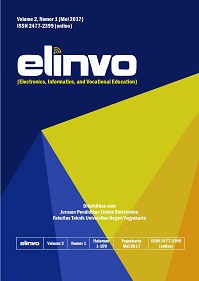Performance Analysis of EMG Signal Classification Methods for Hand Gesture Recognition in Stroke Rehabilitation
DOI:
https://doi.org/10.21831/elinvo.v8i2.76811Keywords:
EMG signal, classifier, stroke rehabilitation, hand gesture recognitionAbstract
References
V. Gohel and N. Mehendale, "Review on electromyography signal acquisition and processing," Biophys. Rev., vol. 12, no. 6, pp. 1361–1367, Dec. 2020, doi: 10.1007/s12551-020-00770-w.
C.-W. Wu et al., "Optimal stimulation during monitored thyroid surgery: EMG response characteristics in a porcine model," The Laryngoscope, vol. 127, no. 4, pp. 998–1005, Apr. 2017, doi: 10.1002/lary.26141.
D. C. Preston and B. E. Shapiro, Electromyography and neuromuscular disorders e-book: clinical-electrophysiologic correlations (Expert Consult-Online), 4th ed. Amsterdam, The Netherland: Elsevier, 2020, doi: 10.1016/C2010-0-68780-3.
G. I. Papagiannis et al., "Methodology of surface electromyography in gait analysis: a review of the literature," J. Med. Eng. Technol., vol. 43, no. 1, pp. 59–65, Jan. 2019, doi: 10.1080/03091902.2019.1609610.
T. Hellig, V. Rick, A. Mertens, V. Nitsch, and C. Brandl, "Investigation of observational methods assessing workload of static working postures based on surface electromyography," Work Read. Mass, vol. 62, no. 2, pp. 185–195, 2019, doi: 10.3233/WOR-192854.
G. Kwakkel et al., "Motor rehabilitation after stroke: European Stroke Organisation (ESO) consensus-based definition and guiding framework," Eur. Stroke J., vol. 8, no. 4, pp. 880–894, Dec. 2023, doi: 10.1177/23969873231191304.
J. Cao, Z. Tian, and Z. Wang, "Hand Gestures Recognition Based on One-Channel Surface EMG Signal," J. Softw. Eng. Appl., vol. 12, no. 09, pp. 383–392, 2019, doi: 10.4236/jsea.2019.129023.
S. I. Khan and R. B. Pachori, "Automated Eye Movement Classification Based on EMG of EOM Signals Using FBSE-EWT Technique," IEEE Trans. Hum.-Mach. Syst., vol. 53, no. 2, pp. 346–356, Apr. 2023, doi: 10.1109/THMS.2023.3238113.
R. B. Azhiri, M. Esmaeili, and M. Nourani, "EMG-Based Feature Extraction and Classification for Prosthetic Hand Control," 2021, arXiv. doi: 10.48550/ARXIV.2107.00733.
S. Jose et al., "Robust Classification of Intramuscular EMG Signals to Aid the Diagnosis of Neuromuscular Disorders," IEEE Open J. Eng. Med. Biol., vol. 1, pp. 235–242, 2020, doi: 10.1109/OJEMB.2020.3017130.
M. M. Khan, M. F. Ammar, H. S. Qarni, A. Waris, and O. Gillani, "USED-I: "Multi-Gesture Surface Electromyography (sEMG) Dataset for Stroke Rehabilitation." IEEE Dataport, Aug. 05, 2023. doi: https://dx.doi.org/10.21227/04zq-yz45.
I. K. N. Krilova, "EMG Data for Gestures." UCI Machine Learning Repository, 2018. doi: 10.24432/C5ZP5C.
Dania Siregar, Faroh Ladayya, Naufal Zhafran Albaqi, and Bintang Mahesa Wardana, "Penerapan Metode Support Vector Machines (SVM) dan Metode Naí¯ve Bayes Classifier (NBC) dalam Analisis Sentimen Publik terhadap Konsep Child-free di Media Sosial Twitter," J. Stat. Dan Apl., vol. 7, no. 1, pp. 93–104, Jun. 2023, doi: 10.21009/JSA.07109.
M. W. Prihatmono, S. Arni, J. N. Iin, and D. Moeis, "Application of the KNN Algorithm for Predicting Data Card Sales at PT. XL Axiata Makassar," Conf. Ser., vol. 4, pp. 59–64, Jan. 2022, doi: 10.34306/conference series.v4i1.692.
V. Y. Kulkarni and P. K. Sinha, "Effective Learning and Classification using Random Forest Algorithm," vol. 3, no. 11, 2014.
D. Borup, B. J. Christensen, N. S. Mí¼hlbach, and M. S. Nielsen, "Targeting predictors in random forest regression," Int. J. Forecast., vol. 39, no. 2, pp. 841–868, Apr. 2023, doi: 10.1016/j.ijforecast.2022.02.010.
S. Bharathidason and C. Jothi Venkataeswaran, "Improving Classification Accuracy based on Random Forest Model with Uncorrelated High Performing Trees," Int. J. Comput. Appl., vol. 101, no. 13, pp. 26–30, Sep. 2014, doi: 10.5120/17749-8829.
B. Talekar, "A Detailed Review on Decision Tree and Random Forest," Biosci. Biotechnol. Res. Commun., vol. 13, no. 14, pp. 245–248, Dec. 2020, doi: 10.21786/bbrc/13.14/57.
M. Azhari, A. Alaoui, Z. Achraoui, B. Ettaki, and J. Zerouaoui, "Adaptation of the random forest method: solving the problem of pulsar search," in Proceedings of the 4th International Conference on Smart City Applications, Casablanca Morocco: ACM, Oct. 2019, pp. 1–6. doi: 10.1145/3368756.3369004.
J. Biedrzycki and R. Burduk, "Weighted Scoring in Geometric Space for Decision Tree Ensemble," IEEE Access, vol. 8, pp. 82100–82107, 2020, doi: 10.1109/ACCESS.2020.2990721.
L. Canete-Sifuentes, R. Monroy, and M. A. Medina-Perez, "A Review and Experimental Comparison of Multivariate Decision Trees," IEEE Access, vol. 9, pp. 110451–110479, 2021, doi: 10.1109/ACCESS.2021.3102239.
J. Liang, Z. Qin, S. Xiao, L. Ou, and X. Lin, "Efficient and Secure Decision Tree Classification for Cloud-Assisted Online Diagnosis Services," IEEE Trans. Dependable Secure Comput., vol. 18, no. 4, pp. 1632–1644, Jul. 2021, doi: 10.1109/TDSC.2019.2922958.
Z. Liu, T. Wen, W. Sun, and Q. Zhang, "Semi-Supervised Self-Training Feature Weighted Clustering Decision Tree and Random Forest," IEEE Access, vol. 8, pp. 128337–128348, 2020, doi: 10.1109/ACCESS.2020.3008951.
I. Mollas, G. Tsoumakas, and N. Bassiliades, "LionForests: Local Interpretation of Random Forests through Path Selection", in Proceedings of the First International Workshop on New Foundations for Human-Centered AI (NeHuAI) co-located with 24th European Conference on Artificial Intelligence (ECAI), 2020, pp. 17-24, doi: 10.48550/arXiv.1911.08780.
S. Ruan, H. Li, C. Li, and K. Song, "Class-Specific Deep Feature Weighting for Naí¯ve Bayes Text Classifiers," IEEE Access, vol. 8, pp. 20151–20159, 2020, doi: 10.1109/ACCESS.2020.2968984.
T. Kim and J.-S. Lee, "Exponential Loss Minimization for Learning Weighted Naive Bayes Classifiers," IEEE Access, vol. 10, pp. 22724–22736, 2022, doi: 10.1109/ACCESS.2022.3155231.
S. Wang, J. Ren, and R. Bai, "A Regularized Attribute Weighting Framework for Naive Bayes," IEEE Access, vol. 8, pp. 225639–225649, 2020, doi: 10.1109/ACCESS.2020.3044946.
Downloads
Published
How to Cite
Issue
Section
Citation Check
License
The article published in ELINVO became ELINVO's right in publication.
This work by ELINVO is licensed under a Creative Commons Attribution-NonCommercial 4.0 International License.








